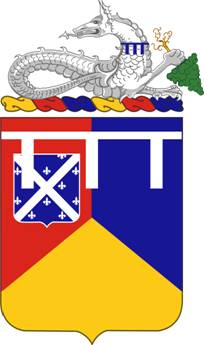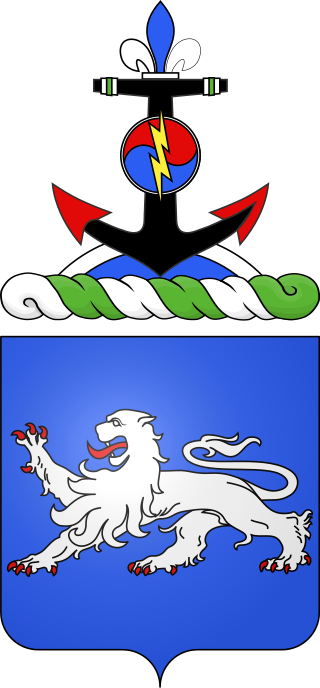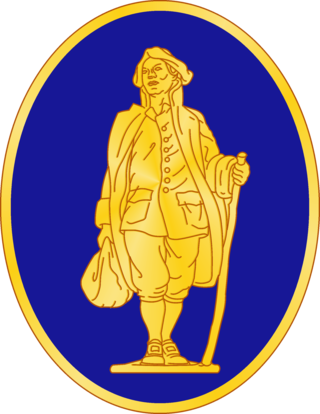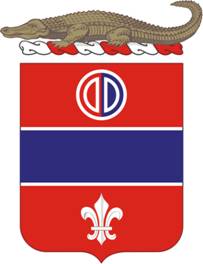
The 31st Infantry Division ("Dixie") was an infantry division of the United States Army National Guard, active almost continuously from 1917 to 1968. Composed of men from Alabama, Florida, Georgia, Louisiana, Michigan, Illinois, and Mississippi at various points in its existence, the division saw service in both World War I and World War II, and was mobilized during the Korean War, although it was not sent overseas in the latter.

The 27th Infantry Division was a unit of the Army National Guard in World War I and World War II. The division traces its history from the New York Division, formed originally in 1908. The 6th Division designation was changed to the 27th Division in July 1917.

The 66th Armor Regiment is the oldest armored unit in the United States Army, tracing its lineage to the 301st Tank Battalion which served with distinction soon after it was formed in the First World War; the 301st trained at Camp Meade, Maryland, where then-Cpt. Dwight D. Eisenhower was an instructor. It has often been rumored that the 301st, the parent unit of the 66th, was first commanded by Col. George S. Patton, but this appears not to have been the case; while Patton was the first officer assigned to the Tank Corps, and while the 301st Tank Battalion was the first unit formed, Patton went nearly immediately to France to train Americans attached to Allied commands. The 301st was the only American heavy tank battalion to have seen action in the war. After the war, the 301st transitioned in the Regular Army to become the 66th Infantry Regiment by way of the 16th Tank Battalion.

The 53rd Troop Command is an administrative headquarters of the New York Army National Guard that provides direction for units not under another brigade or other formation headquarters (HQ). It also provides administrative support to units from other formations in the New York area that are stationed a long way from their higher HQ.

The 68th Armor Regiment is an armored regiment of the United States Army. It was first activated in 1933 in the Regular Army as the 68th Infantry Regiment.

The 108th Cavalry Regiment is a cavalry regiment of the Georgia and Louisiana Army National Guards of the United States Army.

The 19th Infantry Regiment is a United States Army infantry regiment which is assigned to the US Army Training and Doctrine Command, with the assignment of conducting Basic and Advanced Infantry Training.

The 27th Infantry Brigade Combat Team ("Empire") is an infantry brigade combat team of the New York Army National Guard, one of the brigades that make up the 42nd Infantry Division.

The 106th Cavalry Regiment was a mechanized cavalry unit of the United States Army in World War II recognized for its outstanding action. The group was organized in 1921 as part of the Illinois National Guard and during the Spanish–American War and World War I was known as the 1st Regiment Illinois Volunteer Cavalry. It underwent a number of reorganizations before World War II. Like other Guard units during the inter-war years, the 106th held weekly or monthly drills and yearly training. Readiness for war in 1940 led to the mechanization of the unit and induction into federal service at Camp Livingston, Louisiana on 25 November 1940.
The 150th Field Artillery Regiment is a field artillery unit in the Indiana Army National Guard.

The 111th Infantry Regiment, originally the Pennsylvania Militia or "Associators", were a Pennsylvania militia unit that fought in the American Revolution, composed of civilian males from the citizenry of Pennsylvania. It is one of several National Guard units with colonial roots and campaign credit for the War of 1812. The Pennsylvania Militia often fought in conjunction with General Washington and the Continental Army along the Delaware River.

The 124th Infantry Regiment is a parent regiment of the United States Army, represented in the Florida Army National Guard by the 1st Battalion headquartered in Miramar and 2nd Battalion at Orlando. The two Battalions are elements of the 53rd Infantry Brigade Combat Team.

The 102nd Cavalry Regiment is a regiment of the United States Army first established in 1913 and which saw service in World War II.
The 161st Infantry Regiment is a ceremonial infantry regiment of the United States Army and the Washington Army National Guard. It is the oldest unit in the Washington Army National Guard tracing its lineage to the separate Infantry Companies of the Territorial Militia. Its 1st Battalion is a stryker-based element of the 81st Stryker Brigade Combat Team consisting of three stryker infantry companies and one headquarters company, with its headquarters in Spokane, Washington.

The 133rd Infantry Regiment is an infantry regiment in the Iowa Army National Guard. It is represented by the 1st Battalion, 133rd Infantry Regiment, part of the 2nd Infantry Brigade Combat Team, 34th Infantry Division.

First Squadron, 153rd Cavalry Regiment "Darkhorse" is an element of the Florida Army National Guard, headquartered in Panama City, Florida with units throughout the Panhandle. It was formerly 3rd Battalion, 124th Infantry and officially converted to cavalry on 1 September 2007 when the 53rd Infantry Brigade converted from a "separate brigade" to the brigade combat team structure.

The 116th Field Artillery is a regiment of the Florida Army National Guard. Currently there are two battalions; 2-116th FA is fires battalion for the 53rd Brigade Combat Team, and 3-116th (HIMARS) is part of the 164th Air Defense Artillery Brigade, both of the Florida Army National Guard.
The 307th Infantry Regiment was a National Army unit first organized for service in World War I as part of the 77th Division in France. It later served in the Pacific Theater during World War II. Since then it has served as a training Regiment. In 1999, it was withdrawn from the Combat Arms Regimental System and redesignated as a non-branch regiment. The regiment's 1st Battalion is assigned to the 174th Infantry Brigade at Joint Base McGuire–Dix–Lakehurst, New Jersey, with the 2nd Battalion is assigned to the 157th Infantry Brigade at Camp Atterbury, Indiana.

The 105th Infantry Regiment was an infantry regiment of the New York Army National Guard that saw combat in World War I and World War II. Originally, it was known as the 2nd New York Volunteer Infantry Regiment, but it was redesignated in 1916. The 105th fought as a part of the 27th Infantry Division during both World Wars, and was highly decorated for its actions during the Battle of Saipan, where its dogged defense against the largest Japanese Banzai charge of the war decimated its ranks, but prevented the American effort on the island from collapsing.
The 306th Infantry Regiment was a National Army unit first organized for service in World War I as part of the 77th Infantry Division in Europe. It later served in the Pacific Theater during World War II. Since then it has served as a training Regiment. In 1999, it was withdrawn from the Combat Arms Regimental System and redesignated as a non-branch regiment. The regiment's 1st, 2nd, 4th, and 5th battalions are stationed at Fort Stewart under the command of the 188th Infantry Brigade. The 3rd Battalion is inactive.
















